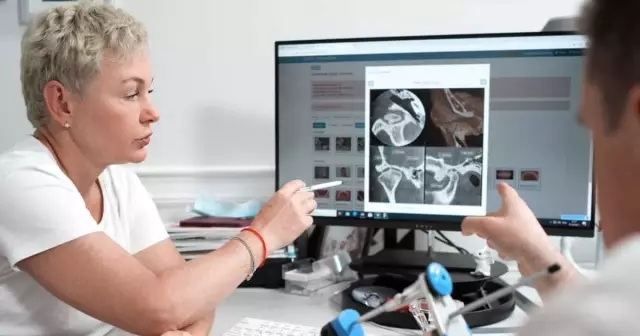- Author Rachel Wainwright [email protected].
- Public 2023-12-15 07:39.
- Last modified 2025-11-02 20:14.
Implantation has become an option for those who have lost several teeth at once
Unfortunately, the loss of even one tooth leads to a change in the entire dentition. What can we say about cases when a person is left without 3-4 or even 10 adjacent teeth. A person faces several difficulties at once - an aesthetic defect, deterioration in the health of the organs of the oral cavity and the whole body, the inability to chew food qualitatively.

Implantation has become the most effective method of treating partial adentia (missing one or more teeth); more information about the technique can be found at the link:
Why is tooth loss dangerous?
With adentia, the work of the entire maxillofacial apparatus is disrupted:
- in the process of chewing, the load on the remaining teeth increases, the gums are injured, while the chopping of food worsens, which subsequently negatively affects the state of the gastrointestinal system;
- when talking and communicating with other people, a person experiences inconvenience, he tries to hide the defect and is ashamed of his appearance;
- facial asymmetry may develop due to the absence of several teeth on one side;
- due to the fact that there are no lateral chewing teeth, a person is forced to chew food with premolars and incisors, which leads to a gradual advancement of the lower jaw forward - the bite changes;
- there is a movement of the teeth near the defect - they move to the side to compensate for the deficiency, the same movement occurs from the side of the contact teeth located in the other jaw (on the upper jaw, the tooth drops towards the defect, on the lower jaw it rises, as a result of which the neck is exposed and part of the root).
As you can see, the loss of even one tooth leads to irreversible changes in the entire system and in the body. Therefore, it is important to start orthopedic treatment as early as possible, this will help maintain health and limit yourself to small expenses.
What happens after dental implantation
Dental prosthetics, in principle, involves the creation of replacement crowns, which must be securely fixed to eliminate the defect. In this case, it is desirable to restore the function of the lost tooth as fully as possible. When using bridges, the last question remains practically unresolved, because the chewing load intended for the missing tooth is redistributed to neighboring, supporting ones. Lysis of the bone tissue of the alveolar process progresses, therefore, over time, the aesthetics of the prosthesis decreases, since a visible gap is formed between the crown and the gum.

Implantation involves the implantation of the stump (analogue of the root) of the tooth into the bone tissue. She will subsequently be put on a crown prosthesis, which will hide the defect. Since the implant is located in the bone, the chewing load is distributed on it in the same way as in the presence of a living tooth, which means that the stimulation of the blood supply to this area will continue in a normal mode. Lysis changes in the alveolar process will not occur, therefore, the aesthetic appearance of the gums and teeth will be preserved for a long time.
In addition, thanks to the implant, there is no need to use adjacent healthy teeth to fix the prosthesis. They will fully perform their function and will not receive additional workload. This will help keep them healthy.
The main advantage of dental implantation is the complete restoration of the chewing function of the maxillofacial apparatus. The restored dentition is adapted for thorough grinding of food, so that the formed food lump will enter the gastrointestinal tract, ready for digestion.

Implantation of just one tooth will help preserve the health of the whole body and restore the joy of life to a person by restoring the aesthetics of the dentition.
We would like to thank the specialists of the Doctor Bon clinic for their help in preparing the material.
Found a mistake in the text? Select it and press Ctrl + Enter.






